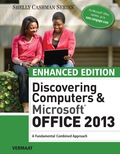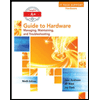
EBK ENHANCED DISCOVERING COMPUTERS & MI
1st Edition
ISBN: 8220100606922
Author: Vermaat
Publisher: YUZU
expand_more
expand_more
format_list_bulleted
Question
Chapter 1, Problem 3.2E
Program Plan Intro
Wireless Technology:
- It refers to communication or transmission of information without wires, cables or any other electrical conductors.
- Initially set up the communication and then transmit the information through air using electromagnetic waves.
- Now wireless technology belongs to a wide range of devices such as mobile phones, laptops, tabs, Bluetooth and so on.
Expert Solution & Answer
Trending nowThis is a popular solution!

Students have asked these similar questions
I need to define and discuss the uses of one monitoring or troubleshooting tool in Windows Server 2019. thank you
I would likr toget help with the following concepts:
- Windows Server features
- Windows Server versus Windows 10 used as a client-server network
I need to define and discuss the uses of one monitoring or troubleshooting tool in Windows Server 2019. thank you
Chapter 1 Solutions
EBK ENHANCED DISCOVERING COMPUTERS & MI
Ch. 1 - Prob. 1SGCh. 1 - Prob. 2SGCh. 1 - Prob. 3SGCh. 1 - Prob. 4SGCh. 1 - Prob. 5SGCh. 1 - Prob. 6SGCh. 1 - Prob. 7SGCh. 1 - Prob. 8SGCh. 1 - Prob. 9SGCh. 1 - Prob. 10SG
Ch. 1 - Prob. 11SGCh. 1 - Prob. 12SGCh. 1 - Prob. 13SGCh. 1 - Prob. 14SGCh. 1 - Prob. 15SGCh. 1 - Prob. 16SGCh. 1 - Prob. 17SGCh. 1 - Prob. 18SGCh. 1 - Prob. 19SGCh. 1 - Prob. 20SGCh. 1 - Prob. 21SGCh. 1 - Prob. 22SGCh. 1 - Prob. 23SGCh. 1 - Prob. 24SGCh. 1 - Prob. 25SGCh. 1 - Prob. 26SGCh. 1 - Prob. 27SGCh. 1 - Prob. 28SGCh. 1 - Prob. 29SGCh. 1 - Prob. 30SGCh. 1 - Prob. 31SGCh. 1 - Prob. 32SGCh. 1 - Prob. 33SGCh. 1 - Prob. 34SGCh. 1 - Prob. 35SGCh. 1 - Prob. 36SGCh. 1 - Prob. 37SGCh. 1 - Prob. 38SGCh. 1 - Prob. 39SGCh. 1 - Prob. 40SGCh. 1 - Prob. 41SGCh. 1 - Prob. 42SGCh. 1 - Prob. 43SGCh. 1 - Prob. 44SGCh. 1 - Prob. 45SGCh. 1 - Prob. 46SGCh. 1 - Electronic components in computers process data...Ch. 1 - Prob. 2TFCh. 1 - Prob. 3TFCh. 1 - Prob. 4TFCh. 1 - Prob. 5TFCh. 1 - Prob. 6TFCh. 1 - Prob. 7TFCh. 1 - Prob. 8TFCh. 1 - Prob. 9TFCh. 1 - Prob. 10TFCh. 1 - Operating systems are a widely recognized example...Ch. 1 - Prob. 12TFCh. 1 - Prob. 1MCCh. 1 - Prob. 2MCCh. 1 - Prob. 3MCCh. 1 - Prob. 4MCCh. 1 - Prob. 5MCCh. 1 - Prob. 6MCCh. 1 - Prob. 7MCCh. 1 - Prob. 8MCCh. 1 - Prob. 1MCh. 1 - Prob. 2MCh. 1 - Prob. 3MCh. 1 - Prob. 4MCh. 1 - Prob. 5MCh. 1 - Prob. 6MCh. 1 - Prob. 7MCh. 1 - fileCh. 1 - Prob. 9MCh. 1 - Prob. 10MCh. 1 - Prob. 2CTCh. 1 - Prob. 3CTCh. 1 - Prob. 4CTCh. 1 - Prob. 5CTCh. 1 - Prob. 6CTCh. 1 - Prob. 7CTCh. 1 - Prob. 8CTCh. 1 - Prob. 9CTCh. 1 - Prob. 10CTCh. 1 - Prob. 11CTCh. 1 - Prob. 12CTCh. 1 - Prob. 13CTCh. 1 - Prob. 14CTCh. 1 - Prob. 15CTCh. 1 - Prob. 16CTCh. 1 - Prob. 17CTCh. 1 - Prob. 18CTCh. 1 - Prob. 19CTCh. 1 - Prob. 20CTCh. 1 - Prob. 21CTCh. 1 - Prob. 22CTCh. 1 - What are some popular programming languages?Ch. 1 - Prob. 24CTCh. 1 - Prob. 25CTCh. 1 - Prob. 26CTCh. 1 - Prob. 27CTCh. 1 - Prob. 1PSCh. 1 - Prob. 2PSCh. 1 - Prob. 3PSCh. 1 - Prob. 4PSCh. 1 - Prob. 5PSCh. 1 - Prob. 6PSCh. 1 - Prob. 7PSCh. 1 - Prob. 8PSCh. 1 - Prob. 9PSCh. 1 - Prob. 10PSCh. 1 - Prob. 11PSCh. 1 - Prob. 1.1ECh. 1 - Prob. 1.2ECh. 1 - Prob. 1.3ECh. 1 - Prob. 2.1ECh. 1 - Prob. 3.1ECh. 1 - Prob. 3.2ECh. 1 - Prob. 3.3ECh. 1 - Prob. 4.1ECh. 1 - Prob. 4.2ECh. 1 - Prob. 4.3ECh. 1 - Prob. 5.1ECh. 1 - Prob. 5.2ECh. 1 - Prob. 5.3ECh. 1 - Prob. 1IRCh. 1 - Prob. 2IRCh. 1 - Prob. 3IRCh. 1 - Prob. 4IRCh. 1 - Prob. 5IRCh. 1 - Prob. 1CTQCh. 1 - Prob. 2CTQCh. 1 - Prob. 3CTQCh. 1 - Prob. 4CTQ
Knowledge Booster
Similar questions
- Please solve and answer the questions correctly please. Thank you!!arrow_forwardConsidering the TM example of binary sum ( see attached)do the step-by-step of execution for the binary numbers 1101 and 11. Feel free to use the Formal Language Editor Tool to execute it; Write it down the current state of the tape (including the head position) and indicate the current state of the TM at each step.arrow_forwardI need help on inculding additonal code where I can can do the opposite code of MatLab, where the function of t that I enter becomes the result of F(t), in other words, turning the time-domain f(t) into the frequency-domain function F(s):arrow_forward
arrow_back_ios
SEE MORE QUESTIONS
arrow_forward_ios
Recommended textbooks for you
 Enhanced Discovering Computers 2017 (Shelly Cashm...Computer ScienceISBN:9781305657458Author:Misty E. Vermaat, Susan L. Sebok, Steven M. Freund, Mark Frydenberg, Jennifer T. CampbellPublisher:Cengage Learning
Enhanced Discovering Computers 2017 (Shelly Cashm...Computer ScienceISBN:9781305657458Author:Misty E. Vermaat, Susan L. Sebok, Steven M. Freund, Mark Frydenberg, Jennifer T. CampbellPublisher:Cengage Learning A+ Guide to Hardware (Standalone Book) (MindTap C...Computer ScienceISBN:9781305266452Author:Jean AndrewsPublisher:Cengage Learning
A+ Guide to Hardware (Standalone Book) (MindTap C...Computer ScienceISBN:9781305266452Author:Jean AndrewsPublisher:Cengage Learning Principles of Information Systems (MindTap Course...Computer ScienceISBN:9781305971776Author:Ralph Stair, George ReynoldsPublisher:Cengage Learning
Principles of Information Systems (MindTap Course...Computer ScienceISBN:9781305971776Author:Ralph Stair, George ReynoldsPublisher:Cengage Learning Principles of Information Systems (MindTap Course...Computer ScienceISBN:9781285867168Author:Ralph Stair, George ReynoldsPublisher:Cengage Learning
Principles of Information Systems (MindTap Course...Computer ScienceISBN:9781285867168Author:Ralph Stair, George ReynoldsPublisher:Cengage Learning Systems ArchitectureComputer ScienceISBN:9781305080195Author:Stephen D. BurdPublisher:Cengage Learning
Systems ArchitectureComputer ScienceISBN:9781305080195Author:Stephen D. BurdPublisher:Cengage Learning

Enhanced Discovering Computers 2017 (Shelly Cashm...
Computer Science
ISBN:9781305657458
Author:Misty E. Vermaat, Susan L. Sebok, Steven M. Freund, Mark Frydenberg, Jennifer T. Campbell
Publisher:Cengage Learning

A+ Guide to Hardware (Standalone Book) (MindTap C...
Computer Science
ISBN:9781305266452
Author:Jean Andrews
Publisher:Cengage Learning

Principles of Information Systems (MindTap Course...
Computer Science
ISBN:9781305971776
Author:Ralph Stair, George Reynolds
Publisher:Cengage Learning


Principles of Information Systems (MindTap Course...
Computer Science
ISBN:9781285867168
Author:Ralph Stair, George Reynolds
Publisher:Cengage Learning

Systems Architecture
Computer Science
ISBN:9781305080195
Author:Stephen D. Burd
Publisher:Cengage Learning